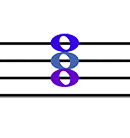
HARMONIC EXPANSIONS: Watch your harmonies grow!
 |
 |
 |
INTRODUCTION
|
Harmonic Expansions is designed to introduce the concept of expanding harmonies to first year Music Theory students by using multimedia presentations on the World Wide Web. To this end every four part example is a systematic expansion of the tonic triad. Students also have opportunities to practice their listening skills with dictations which are similarly derived expansions. While acknowledging their limitations in scope, these pages are also intended to provide a glimpse of what a stand-alone web-based text would look like. Music Theorists will recognize several concepts on these pages that were introduced by Heinrich Schenker, including harmonic expansion (or "prolongation" or "elaboration"), the Urklang (referred to here as the "primordial tonic"), the fundamental harmonic progression and analytical levels. One motivation for writing these web pages was to present these concepts to first year students in a systematic way. However, these pages are not meant to be a comprehensive explanation of Schenker's theories. |

|
This web-based presentation supplements traditional textbook explanations of chord progressions by taking advantage of features which are impossible in printed media:
Students can begin Harmonic Expansions after
Harmonic Expansions is not a substitute for early voice leading chapters in a traditional textbook. While voice leading is an integral part of the explanations of linear expansions on these pages, students will not learn to write music in four voices satisfactorily without working through traditional pencil and paper exercises found in text books and their accompanying workbooks. I am indebted to Anthony Kosar and Michael Levi who were my instructors at Advanced Placement Summer Institutes; to Brent Sandene and Janet Waanders, of the Educational Testing Service, who nominated me to the Development Committee of the Advanced Placement Music Theory Exam; and to all the members of this committee, especially my two committee chairs Jane Clendinning and Patrick McCrellis. Thank you, all. |
|
 |
 |
 |
 |



